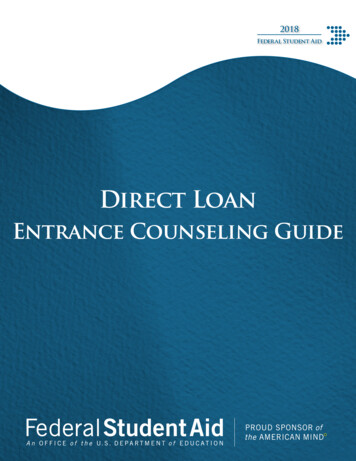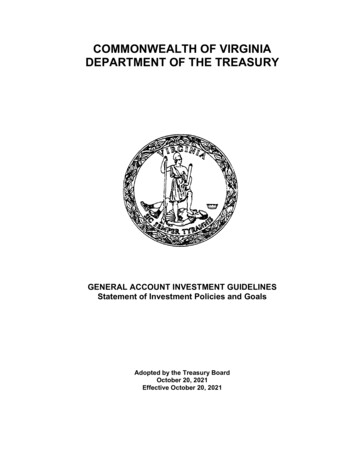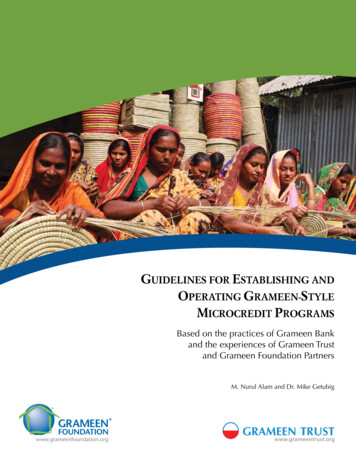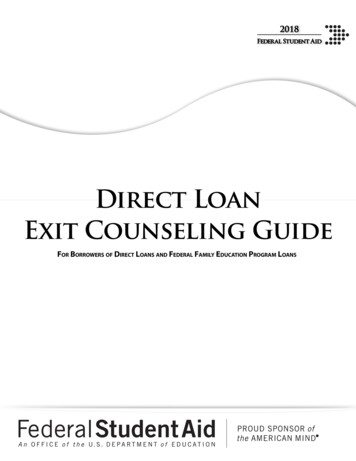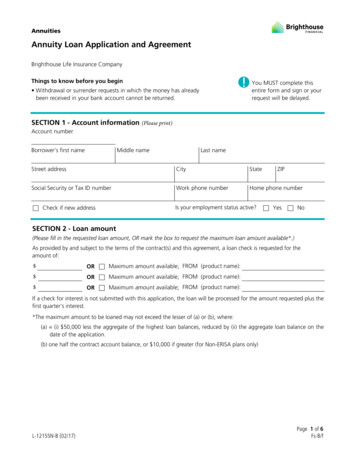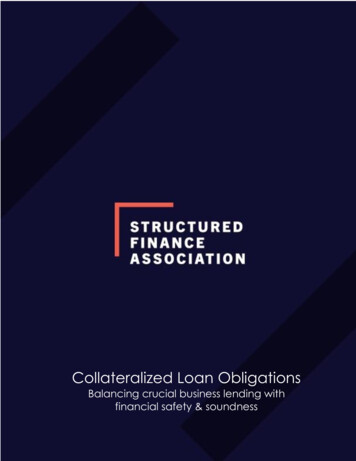
Transcription
Collateralized Loan ObligationsBalancing crucial business lending withfinancial safety & soundness
Collateralized Loan ObligationsA look at this asset as a long-term financing solutionfor non-investment grade corporations Serving a very large and important financing source for U.S. businesses, CLOs makebusiness lending more available and affordable – but the market bears watching.Market participants must continue to remain vigilant in order to maintain creditavailability to U.S. businesses in a responsible manner to promote safety andsoundness, protect the financial system, and support American economic growth,job creation and success.BY Elen Callahan, SFA Head of ResearchFebruary 2020Key Takeaways Collateralized Loan Obligations may sound complex to many outside the financial industry but are simplycertain types of business loans packaged into bonds and purchased by institutional investors. CLOs serve as a very important financing source for U.S. businesses, making credit more available andaffordable to thousands of corporate borrowers with high levels of debt or are rated below investmentgrade (BBB). CLOs provide 50-65% percent of funding for these companies. As the U.S. economy has grown, so has business lending and loans packaged into CLOs to finance theexpansion. Additionally, there has been some deterioration of underwriting standards during this time.This has led to appropriate concern about – and closer monitoring of – this financial segment to ensureits safety and soundness in the event of an economic downturn. Nonetheless, CLOs are structured in a way to actively manage risk for the bond investors. Assetmanagers carefully select institutional loans. CLO bonds range from AAA-rated at the top of thewaterfall to B-rated and unrated equity at the bottom. CLO bonds performed well during the financialcrisis, with no defaults due to collateral deterioration at the AAA or AA notes and less than 0.01% for Aand BBB-rated notes. This performance further stands out when juxtaposed to corporate bondperformance during the financial crisis when the default rate for investment-grade corporate bondsrose to 0.42% and non-investment grade corporate defaults reached 9.94%. Furthermore, even though CLO’s performed well in 2008-2010, since the crisis, many aspects of the CLOmarket are notably more conservatively managed with tighter ratings criteria by ratings level, tightercollateral eligibility requirements and shorter reinvestment periods.
Collateralized Loan Obligations Primer Although a severe economic downturn may result in meaningful CLO deterioration, we posit that thereare several structural mitigants that limit the impact on the broader economy. Today’s CLOs lack thesynthetic exposure and “re-securitization” structures of past CDOs which were backed bythe subordinate bonds of other CDOs or other securitized bonds like subprime RMBS, CMBS and CDOs(e.g., “CDO-squared”). These synthetic CDOs and CDO squared structures – mainly backed by mortgagerisk pre-crisis – amplified correlation and credit risk and made these earlier CDOs more susceptible tocatastrophic loss. Moreover, the maturities of CLOs liabilities are matched to underlying assets andCLOs do not mark-to-market their loans which protects the CLO market valuation even as the underlyingmarket declines. As noted by Federal Reserve Chairman Powell “while CLOs have facilitated the growthof leveraged loans, many have stable funding: Investors commit funds for lengthy periods, so theycannot, through withdrawals, force CLOs to sell assets at distressed prices.” As with all asset classes, it is important for industry participants, regulators, and policymakers tocontinue to monitor risk across the market. Market participants understand that the past does notalways predict the future, and the next downturn will not necessarily follow the blueprint of pastrecessions.2
Collateralized Loan Obligations PrimerOverviewU.S. companies need financing to innovate, operate, expand, combine and create jobs. Many driversof today’s business and economic expansion succeed because funds for classic American risk-takingingenuity are more available, at better rates, when their loans are packaged into investmentsecurities—e.g. bonds—called Collateralized Loan Obligations, or CLOs.CLOs are an important form of structured financing. Like asset-backed securities that help familiesfinance automobile and homes, CLOs help business leaders finance their companies. CLOs are createdwhen banks and other financial institutions combine similar business loans into bonds, which in turn arepurchased by investors—including pension and retirement funds—to earn interest income, managetheir portfolios, and support growing businesses.The CLO “securitization” process replenishes funds to lend to thousands of non-Fortune 500businesses, making credit more available and affordable even to sub-investment grade enterprisesworking for a chance to grow and thrive.While fueling America’s corporate growth, CLOs help to expand the investor base in business loans,bringing more liquidity and stability to this important market. Through fixed income mutual funds orclosed end funds, CLOs give investors, such as families building college, retirement and other nest eggs,a floating rate investment alternative with a history of strong credit performance—while also adheringto post-Recession financial reforms.As the U.S. economy has grown, so has business lending and loans packaged into CLOs to finance theexpansion. This has led to appropriate concern about—and closer monitoring of—this financialsegment to protect investors and financial system safety and soundness.This SFA paper discusses the CLO market, issues raised, and how CLOs help to support business lending,while also supporting the market view that vigilance is warranted with an eye toward balancing andpreserving the shared twin goals: Protecting investors and the financial system, while keeping creditflowing to U.S. companies and the economy in a responsible way.The CLO Explained: BasicsA CLO is a fixed-income bond that holds and manages a diversified portfolio of corporate leveragedloans. The underlying leveraged loans are term debt instruments issued by companies with ratingsbelow investment grade and with higher debt service costs relative to earnings versus investment gradecompanies. Each CLO is structured according to various investor and rating agency criteria, withempirically based levels of safeguards including credit enhancement and portfolio-specific tests and3
Collateralized Loan Obligations Primermechanisms that are meant to protect investors against some of the potential risks of the investment.Importantly, CLOs are actively managed by professional credit managers whose loan selection andreinvestment decisions have a material impact on the quality of the underlying portfolio. Through theinfrastructure of securitization, CLOs allow institutional investors to take an investment position in thecorporate sector directly in proportion to their risk appetite, which in turn supports the growth of noninvestment grade companies and their ability to borrow. That is, investors with high risk appetite caninvest in lower rated tranches that offer initially higher yields, while investors with lower riskpreferences can purchase bonds that enjoy the credit enhancement – or loss absorption – of thesehigher yielding/lower rated tranches. Such mechanisms allow businesses to finance themselves all-in atlower interest rates, while matching credit risk with investor preferences in an efficient system.CLO collateral typically reflect the diversity of U.S. industries as represented in the non-investmentgrade U.S loan universe. These companies use these loans (known as “leveraged loans”) to financemergers and acquisitions activity, refinance existing debt, manage a company’s capital structure and forgeneral operating purposes.Exhibit 1: Top 10 obligors of CLO and lev loan universeTop 10 obligors in CLOsAsurion LLCTransDigm IncAmerican AirlinesVistra Operations CompanyDell InternationalCSC Holdings LLC (Cablevision)CenturyLink IncLeveraged Loans: by industry typeInsuranceAerospace and DefenseAirlinesElectric UtilitiesTechnologyMediaDiversified TelecommBausch Health CorporationsPharmaceuticalsUnivision CommunicationsMediaAlbertson's LLCFood and StaplesSource: S&P Global Ratings – “The Most Widely Referenced Corporate Obligors in Rated U.S. BSL CLOs: Second-Quarter 2019”July 8, 20194
Collateralized Loan Obligations PrimerThe CLO Explained: Investment StructureCLOs are investment vehicles that invest in a diversified pool of senior secured leveraged loans byissuing tranches of debt and equity. The debt tranches are typically rated by at least two ratingagencies, with credit ratings from triple-A, the most senior tranche, down through the most juniortranche, either double-B or single-B.CLO bonds are directly repaid from interest and principal paid on the underlying corporate loans withthe senior most triple-A bond being paid first, followed by the mezzanine and the most junior notes.The equity piece, which is not rated, sits below all the debt bonds and is only paid to the extent that thestructure has excess cash once the management fees, debt coupons, and subordinated fees are paid.Any principal payments received during the reinvestment period (typically a two- to five-year period)are reinvested (the manager can either purchase or sell bank loans to improve the portfolio’s creditquality) or used to cover any interest shortfall. Principal payments during the amortization period areused to pay down note principal sequentially. This priority of payments is also called the paymentwaterfall.Exhibit 2: From loans to CLOsSource: SFA, Fitch Ratings5
Collateralized Loan Obligations PrimerCrucial to the CLO structure is the minimum required credit enhancement levels based largely upon thecollateral quality and deal structure. For a bond to attain a triple-A rating, it should be able to withstandan extreme level of stress without going into default. “Extreme” in the case of S&P’s triple-A equates tounemployment rate greater than 20%, a GDP decline greater than 15%, and stock market index declineof less than 70%. Compare this to a bond with a single-B rating where a “mild” level of stress may resultin a missed payment. “Mild” is defined by S&P as unemployment rate of less than 6%, a GDP decline of0-0.5% and a stock market decline of 0-10%. The senior bonds are the most protected from creditlosses, as losses are absorbed first by the equity piece, then from the junior-most bonds to the triple-Abonds. Pricing reflects the risk/reward position of the bonds with the safest, most senior triple-A piecereceiving the lowest return and the equity piece, the highest return.Credit enhancement is found in the form of “overcollateralization”, “excess spread” and/or“subordination”, as discussed in Exhibit 3 below. CLOs are also designed with dynamic coverage testswhich address variability of cash flow used to repay the CLO bonds (i.e., principal and interest paymentson the underlying leveraged loans) and when breached redirect cash flow to protect most senior bondsor to replenish levels of credit enhancement. KBRA summarizes CLO credit enhancement features here:Exhibit 3: Structural protections - credit enhancement and coverage testProtection TypeSummaryPurposeSubordinationRequires cash flows from thecollateral pool to be paid outin sequential priorityCreates priority claim for seniornoteholders and cushion againstlossesAmount of junior notes andequity in the structure: morecreates more and vice versaOvercollateralizationCLO maintains a portfoliowith greater par balance thanoutstanding balance of rateddebtCreates first-loss equity tranche,which is unrated and providescushion against principal lossesto rated debtAmount of equity in thestructure: more creates more asproceeds from sale of equityused to buy collateral over andabove rated debt notionalExcess SpreadInterest generated by thecollateral pool is greater thaninterest owed to rated debt,creating excess availableinterest for the transactionCreates additional cash bufferthat can be captured and used toreplenish lost senior creditenhancementArbitrage: portfolioconstruction, cost of debt andexpenses, performance ofassets over timeInterest CoverageTestRatio: Interest available /Cumulative interest due torated debt at target ratinglevelEnsure adequate interestcoverage. A breach of ratiothresholds triggers a return ofprincipal (reduce testdenominator) to most seniorclass until the test is back incompliancePortfolio construction, cost ofdebt and expenses,performance of assets overtime6Key Drivers
Collateralized Loan Obligations PrimerInterest DiversionTest: (Duringreinvestment periodonly)Ratio: Collateral par /outstanding balance of totalrated debtA breach of ratio forces themanager to purchase additionalcollateral using interest proceeds(increase test numerator) untilthe test is back in compliance.Usually only one test intransaction.Asset selection (risk assets gethaircut in numerator),performance of assets over time(downgrades to CCC, defaults)OvercollateralizationTestRatio: Collateral par /outstanding balance ofcumulative rated debt attarget rating levelEnsure adequate par coverage.Breach of threshold triggers areturn of principal (reduce testdenominator) to most seniorclass until the test is back incompliance and subsequentlystops interest payments to debtbelow the test. Separate tests formost classes of notes.Asset selection (risk assets gethaircut in numerator),performance of assets over time(downgrades to CCC, defaults)Source: KBRAAn important coverage test for CLOs is the exposureto loans with ratings of Caa1/CCC or lower (“the triple-Cbucket”). CLOs are typically structured to hold 7.5% ofloans in this bucket, although some have lower limits. Ifthis limit is breached, the CLO’s protective cushionagainst losses, or overcollateralization,will be considered jeopardized and cash flow may bediverted away from junior classes to protect seniorclasses. To cure a breach, CLO managers will seek to sellthese lower-rated loans, often at some discount.Arguably one of the most important credit enhancementcomponent in the CLO structure is the contribution of anComposition of CLO loan portfoliosThis is an area worth watching as CLOmanagers have increasingly purchased moreloans rated single-B or single-B minus, the ratinglevels immediately above the pivotal triple-Clevel and historically vulnerable to ratingdowngrades. According to S&P, the averageexposure of CLOs to loans rated single-B minusreached a new high of 20% in 2019, up from15% in 2018. Of these loans, 18% carry anegative rating outlook from the ratingagency. S&P’s CLO index currently shows thaton average 4.6% of the loans held by today’sCLOs are rated at triple-C or below, well withinthe 7.5% limit of most CLO structures.active, seasoned portfolio manager. The ability of amanager to impact CLO performance is clear when considering the CLO’s life cycle. For 6-9 monthsbefore a CLO is priced, the manager has been purchasing loans in a warehouse facility to meet a specificinvestment strategy. Once the CLO is sold to capital market investors, the manager has a few moremonths to finalize the pool of assets before a 2 – 5-year reinvestment period kicks off. During thisperiod, the manager is actively trading loans within pre-defined parameters of the CLO structure, usingfunds generated by principal payments from the underlying pool. Interest payments generated by theloan pool are passed through to the bond holders sequentially from highest to lowest rated as interest7
Collateralized Loan Obligations Primerpayments on each bond. Once the reinvestment period ends, the structure enters the amortizationphase, the manager’s ability to trade stops or is drastically limited, and the principal on the bonds arerepaid in sequential order from highest to lowest rated.Exhibit 4: CLO lifecycleSource: SFATo date – including through the 2008 financial crisis - no triple-A CLO bond has defaulted. Only one doubleA bond has defaulted which was due to a flaw in the structure and not to deterioration in theunderlying collateral. Indeed, out of 11,409 CLO tranches rated by S&P between 1994 and 2019, only40 tranches, or 0.004% of the rated tranches, have defaulted; 22 of the defaulted tranches came fromthe double-B slice. All of the defaulted tranches came from CLOs issued between 1994-2009; none ofthe tranches issued from CLOs between 2010 to present (also known as CLO 2.0) experienced a default.Importantly, these CLO 2.0s benefit from more conservative structures. For example, the subordinationlevel for the triple-A bonds of a CLO 2.0 structure may be up to 40% higher than the subordination levelof a CLO 1.0 structure.8
Collateralized Loan Obligations PrimerExhibit 5: Actively managed CLOs have consistently shown lower rate of non-performingleveraged loansNote: Red line represents the percentage of non-performing loans held by S&P-rated CLOs. S&P defines non-preform asloans with ratings of ‘CC’, ‘SD’, or ‘D’.Source: S&P Global RatingsExhibit 6: Default rate comparisons – CLOs vs. corporate bonds2.00%1.47%1.50%1.00%0.50%0.10%0%CLO 1.0CLO 2.00.00%Average corporatebond default rate1994 - 2018Source: S&P Global Fixed Income Research and S&P Global Market Intelligence's CreditPro .9
Collateralized Loan Obligations PrimerCumulative Defaults: by rating .5%1.5%1.1%0.9%1.1%2.1%5.1%15.8%28.3%Source: S&P Global Fixed Income ResearchThe CLO Explained: The CollateralOne of the drivers in CLO performance has been the strength of its collateral. Using a combination ofdebt and equity offerings, U.S. companies access the capital markets to grow their business andmanage their operations. This combination of financing, also known as a company’s capital structure,may be a mixture of long- and short-term debt as well as common and preferred stock.Leveraged loans are floating-rate term debt instruments, with maturities of 5-7 years, that are typicallyused by corporate borrowers with higher debt relative to earnings and credit ratings that are belowinvestment grade. For these companies the cost of issuing unsecured bonds may be too onerous.Leveraged loans, which are arranged and distributed by large sell-side firms and are priced and tradedin the secondary market, provide these corporate borrowers an important access to institutionalfunding. To compensate investors for higher perceived credit or default risk, leveraged loans offeryields that are markedly higher than higher-quality investment grade debt and are backed or securedby an issuer’s assets, property or rights to inventory or receivables.Exhibit 7: Typical yield comparisonYield5-year Treasury1.67%Triple-A bond 6-yr maturity2.23%S&P Leveraged Loan 100 Index5.79%Source: SFA10
Collateralized Loan Obligations PrimerAs loans typically sit in the senior-most position in a company’s capital structure, in the event of abankruptcy, leveraged loans are repaid before senior unsecured bonds, subordinated bonds and equity.This has historically led to higher recovery rates than subordinated debt instruments, although actualrecovery experience will vary depending on issuer, industry or macro related factors. According to S&PGlobal, leveraged loans have an average recoveryrate of 79% compared to 66% for senior secured bondsand 47% for senior unsecured bonds. Leveragedloans have terms in the contract for the safety of theWhat is a cov-lite loanlender called covenants that requires the company tooperate within certain rules such as requirements toCov-lite loans closely resemble seniorfurnish audited financial statements, maintain adequatesecured bonds in that, like bonds, these loansinsurance and/or refrain from entering into certaincontain incurrence covenants that are onlytriggered if the borrower takes some sort ofactions that could result in the deterioration of theiraction — such as adding on more debt orability to repay existing debt. Historically, leveraged loansmaking an acquisition. In these cases, theincurrence covenant limits a borrower’s abilityhave included fairly stringent “maintenance” covenantsto take such action. Cov-lite loans lack thewhich are tied to a borrower’s financial performance andmore restrictive maintenance covenantsmay, arguably, act as an early indication of a borrower’sfound in traditional covenant heavy loans thatrequire borrowers to meet regular, oftenfinancial distress. If breached, the lender typically canquarterly, financial tests. It’s worth noting thattake several actions such as demand immediatein cases where the borrower also has accessto a revolving credit facility, the revolverrepayment of the loans, increase the interest rate on thealways requires financial covenant protectionloan, increase the amount of collateral and/or waive thethat indirectly impacts the cov-lite loan. Whilecovenant following some sort of loan renegotiation,some argue that the presence ofmaintenance covenants provides lendersoften with more stringent loan terms.Today’s low-default environment has given rise toborrower-friendly developments. The most talked aboutof these are the covenant-lite (or cov-lite) loans thatincorporate borrower-favorable terms such as liberalEBITDA add-backs and opportunities for collateralstripping. “EBITDA add backs” add back one-time orextraneous expenses to earnings, thereby increasingEBITDA and improving a borrower’sperceived capacity to repay. Collateral stripping occurswhen borrowers move collateral out of the reach ofsecured lenders, effectively harming the recovery valueof secured loans in the event of a bankruptcy event.11with an important, early warning signal offinancial distress, others have noted that thepresenceofrestrictive,maintenancecovenants may push a distressed borrowerover the edge, as the cure becomesfinancially burdensome to the borrower.The lack of maintenance covenants hassome impact on loan recovery. Forcompanies that exited bankruptcy betweenJanuary 2014 and December 2017, theaverage recovery rate on cov-lite loans was72%, compared to 82% for non cov-lite loans,according to S&P Global Ratings. It is worthnoting that the sample size for this evidenceis very small, at 17 observations. In addition,as covenants have evolved, the requiredcredit enhancement to protect against thesechanges as increased, too.
Collateralized Loan Obligations PrimerCov-lite loans are not new to the leveraged loan space but were limited to higher credit qualityborrowers. On average, cov-lite loans only represented about 14% of the annual leveraged loans issuedpre-crisis. By 2012, that number was closer to 40% and peaked at 80% in 2018. Today, cov-lites makeup 75% of loans outstanding. However, lacking historical data across various market conditions, the juryis out on how cov-lite loans will perform in an economic downturn. Generally speaking, cov-lite loansare considered negative from a recovery perspective relative to more traditional covenant-heavy loans.Some market participants are calling for recovery rates in line with senior secured bonds, given thesimilarities between the two instruments. As with covenant-heavy loans, actual recoveries will beimpacted by a company’s overall debt structure, asset quality and market conditions. In SFA’s view, asdiscussed in more detail below, CLO backed by cov-lite loans do not pose systemic risk given, amongother considerations, the relative size of the market and the more overall conservative protections forCLO investors, but they are an area of the CLO market that is worth watching. Importantly, SFA investormembers agree, and thus pricing and demand is reflective of shifting investor demands andpreferences.Despite these concerns, the still-benign credit environment and robust corporate balance sheets havehelped fuel the growth of the leveraged loan market. Investors include banks, finance companies andinstitutional investors, such as hedge funds, high-yield bond funds, pension funds, insurance companiesand, in no small part CLOs. Since 2013, an average of 350 billion of new leveraged loans issuedannually. During this same period an average of 104 billion of CLOs backed by leveraged loans, wereissued annually. In 2018, the notional amount of loans outstanding cleared the 1 trillion mark for thefirst time in its history; CLO outstanding was about 700 billion as of Q2 2019.Exhibit 8: Issuance volume (in billions)Source: S&P Global Ratings, Bloomberg12
Collateralized Loan Obligations PrimerWhat we’re watchingThe end of LIBORLeveraged loans and CLO bonds have historically been indexed to LIBOR. The end of LIBOR, which isexpected in 2021, and the impending transition away from this benchmark may be messy for legacyCLOs if the industry does not come to an agreement on the standard fallback language before thebenchmark goes away. For a more detailed discussion on the transition risks including litigation risksaround legacy instruments, please see our discussion here. The good news, however, is that the Fedconvened Alternative Reference Rates Committee (ARRC), of which SFA is a member, has beenexploring various possibilities including a possible legislation solution. Please see our discussion here ona possible legislation solution proposed for New York State.Rising credit riskMuch has been said about the shifting credit profile of the leveraged loan universe and the level ofindebtedness of U.S. corporations. We looked at the rise of more borrower-friendly terms in ourdiscussion of the loan collateral and, in our discussion on the CLO structure, the increasing risk thatCLOs face to loans rated triple-C and below. Below we take a look at the level of corporate debt.Although the level of corporate debt has been rising since the financial crisis, and now represents closeto 50% of GDP, that in and of itself should not be a cause for alarm as a certain level of risk taking is keyto the healthy functioning of the capital markets and therefore important for economic growth.Additionally, the rise in corporate debt has been consistent with the rise in corporate profits andmarket values. The graph below shows that today corporate debt is a third of the market value ofcorporate equities and corporate profits after tax stand at 1.8 trillion; compare this to Q4 2008 whendebt was 62% of market value and corporate profit was 721 billion. Additionally, still-low interest rateshave helped kept debt service burdens manageable.To the extent that we see a slowdown in global macroeconomic variables, today’s debt levels may posea challenge for vulnerable corporates with higher levels of debt relative to earnings. Using data fromhigh-yield bond markets as a proxy for the leveraged loan markets, the Financial Stability Board recentlyexamined the vulnerabilities and potential financial stability implications of higher levels of corporateindebtedness. Their analysis shows that the correlation between the level of corporate leverage anddowngrades increases during an economic downturn (left graph), with higher leveraged corporatesexhibiting stronger correlation. The correlation between high-yield downgrades and high-yield bondand leveraged loan default rates also increases during this period.13
Collateralized Loan Obligations PrimerExhibit 9: Current state of corporate debtExhibit 10: Correlation with corporate downgradesSource: Financial Stability BoardDuring a period of high market vulnerability, we would first expect to see further and pronouncedtiering of CLO platforms based on manager quality as increasingly risk-averse investors look formanagers who have proven track records of navigating choppier economic waters. Higher levels ofindebtedness may also lead to lower recoveries on defaulted assets which would contribute to14
Collateralized Loan Obligations Primerstructural stress on CLOs. To the extent that a deterioration in the underlying leveraged loan assetsbreaches structural triggers in CLOs, lower-rated junior tranches will be most vulnerable as cash flowshifts to protect senior tranches.Systemic Risk?In discussions of risks to the broader financial systems, CLOs have been incorrectly compared tosubprime CDOs, the structured credit product that is widely cited as having contributed to the 20072008 financial crisis. CDO, or collateralized debt obligation, is the general term for a structured financeinstrument that is backed by bank loans (as in the case of CLOs) or a pool of bonds or other debtinstruments (such as the case with structured finance CDOs or CBOs, collateralized bond obligations).It’s important to note that while CLOs utilize similar structural technology the similarities end there.Exhibit 11: Key features of CDOs then and CLOs nowCDOs in 2007CLOs in 2018Types of Underlying Asset Non-Agency MBS, other CDOs and ABS,CDS Leveraged loansSize of Underlying Market 2.4 trillion non-agency MBS 1.2 trillion 978 billion CDOs 851 billion ABSComplexityResecuritization (CDOs thatinvested in other CDOs) 14% of outstanding MinimalSynthetic securitizataion(through CDS or otherderivatives) 40-50% of issuance MinimalMaturity transformation (i.e.,long-term CDO assets fundedwith short-term liabilities –creating forced sellers) Common to fund via short-term asrepurchase facilities Minimal SIVs funded with short-term ABScommercial paperSource: BIS Quarterly Review, September 2019 and SFA15
Collateralized Loan Obligations PrimerAt the end of 2008, 525 billion of CDOs were backed by subprime mortgage bonds. These CDOsmostly held interest in pools of mortgage loans made to subprime consumer borrowers. A decline inhousing prices therefore led to the underperformance of these subprime CDOs. Synthetic CDOs andCDO squared amplified correlation and credit risk that made CDOs more susceptible to catastrophicloss.Add to the mix, l
preserving the shared twin goals: Protecting investors and the financial system, while keeping credit flowing to U.S. companies and the economy in a responsible way. The CLO Explained: Basics A CLO is a fixed-income bond that holds and manages a diversified portfolio of corporate leveraged loans.

